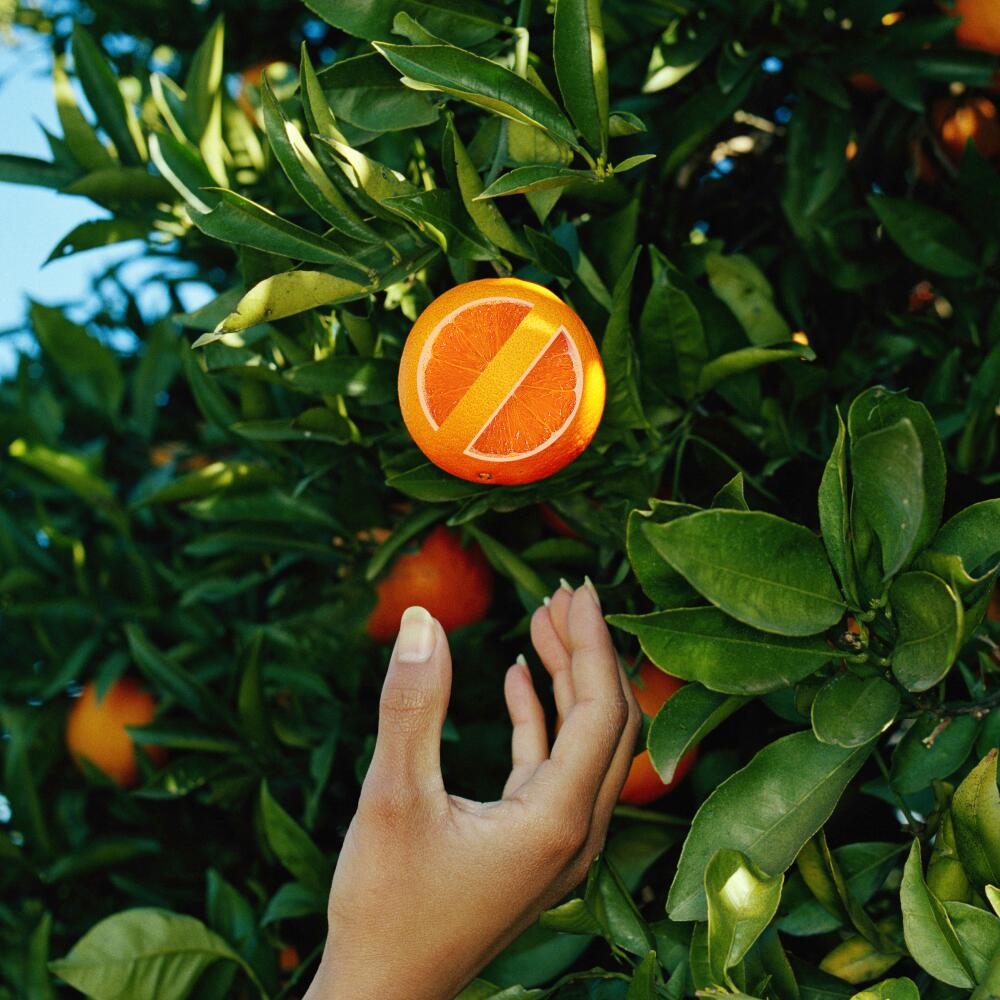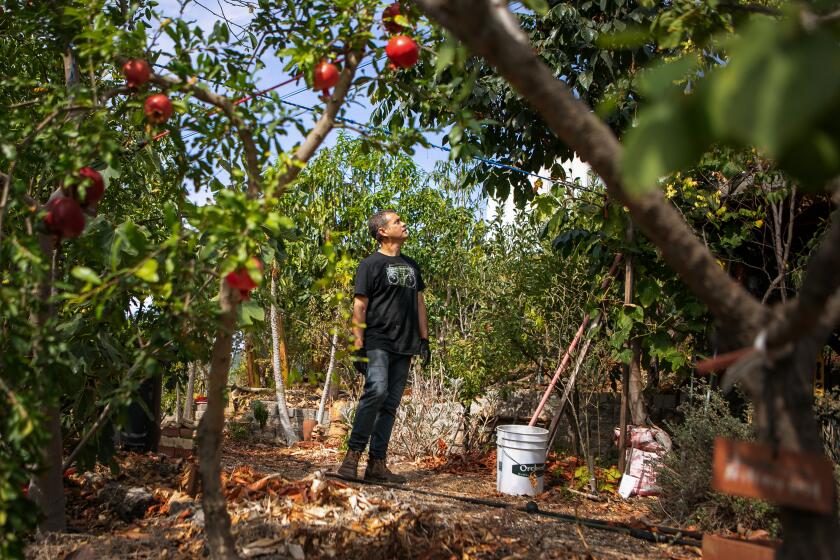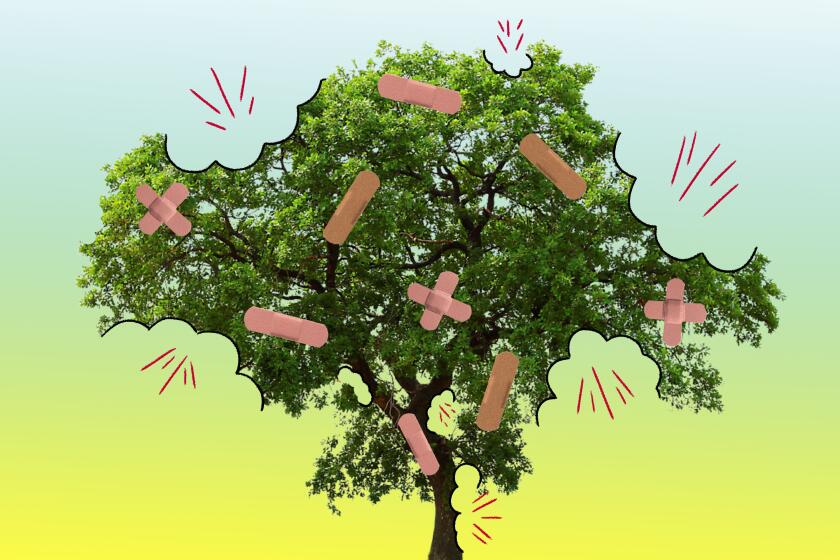
One morning last summer I was sitting at my desk, staring idly out the window, when a woman stopped in front of a nectarine tree in my front yard. The fruits were small and still pretty hard, so I had been waiting to try them. Watching her, I felt a little proud. Maybe she was admiring how many I had?
Then she suddenly looked me square in the face, reached into the branches, snapped off two of the largest fruits and walked away.
I was as stunned as I was indignant. How could she just take my fruit without permission!? Especially because, I reasoned, if she’d asked me, I probably would have said, “I don’t think they’re ripe yet, but sure, give one a try.”
Sign up for our L.A. Times Plants newsletter
At the start of each month, get a roundup of upcoming plant-related activities and events in Southern California, along with links to tips and articles you may have missed.
You may occasionally receive promotional content from the Los Angeles Times.
But here’s the other truth: My trees are right next to the sidewalk, and very easy to harvest while standing in a public space. I did that partly because my yard isn’t very deep, and partly because I had this vision of me magnanimously sharing my bounty with whoever walked by when the trees began bearing fruit.
And all it took was one brazen grab-and-go to mock my noble intentions.
That “interlude,” and my daily walks through a neighborhood teeming with unpicked residential fruit, made me wonder: Is it ever OK to take someone else’s fruit? I took the question to readers to weigh in. And wow, did you weigh in. We got an astonishing 855 replies, most of which came back with a resounding ... “It all depends.” (Totals may exceed 100% because respondents could select multiple answers.)
Basically, if the fruit is close enough to be grabbed from a public right of way, or your own backyard, more than half of respondents gave a thumb’s up to helping yourself. (No comment on whether you should look the owner in the eye before picking.)
Only 19% said “Never” to the question, “When is it OK to pick fruit from someone else’s tree?” Half voted with my help-herself visitor, saying it was OK to take fruit accessible from a public sidewalk or street, or hanging on a branch growing in their own yard.
Fallen fruit is even fairer game, according to respondents, especially if it falls into your yard. Half the respondents were OK with picking up fruit lying in a public street or gutter, but most backed away from picking up fruit on someone else’s property, even if it was easy to reach from the street.
Instead of a lawn, Jose Ramirez planted 250 trees, including avocados, limes, apples, mangoes and even coffee beans in his Boyle Heights yard.
Only a few respondents said “Never” to gleaning fallen fruit, although one had a sobering comment that gave me pause: “Fallen fruit likely has been pissed on by local dogs.”
When it came to picking fruit from laden but apparently neglected trees, nearly 60% of respondents said the best course of action was to knock on the door and ask the owner if you could take some, even if the fruit was easy to access from a public space.
“It is common for people to become overwhelmed by the amount of fruit a tree produces,” wrote environmental specialist Douglas Kent, a forager and author. “More often than not, they would love to see it go to a good use and neighbor. I have never been turned away.”
On the other end of the spectrum, one respondent had a more dramatic take. While it’s best to knock and ask, inquirers should take care, because, they warned, “In this modern age this could result in anything from a bawling out to your death from someone ‘defending their property.’”
Another possibility: perhaps being recorded by a home security camera — and later shamed on neighborhood social networks for taking fruit without asking.
Many others, however, saw knocking and asking as a way to build community and extend some kindness. “Ask if the resident needs help harvesting the fruit, and then ask if it is OK if I can take some fruit,” wrote one.
Nearly a third of the respondents said it was best to just leave the tree and its owner alone.
“It is a waste of good fruit but unless you are a neighbor in good standing don’t touch,” wrote one. “If you know the tree owner, definitely ask if you can take some. If they are elderly or unable to clean up fallen fruit, offer to help in exchange for fruit. Also, after you have enjoyed your fruit, bring a small food-related gift (a nice bread or muffins/cookies) or just a card as a thank you.”
About 20% thought it was OK if you only took one or two pieces of fruit easy to reach. (“If they are leaving it to rot then they aren’t the type of people to ask,” wrote one.)
Only a few endorsed the idea of just helping yourself, but there were some passionate advocates among this minority: “If it’s accessible to the public, then the public should have the right to enjoy it,” wrote one. “The tree’s right to reproduce supersedes the colonialist concept of ‘landownership.’”
Which brings us to the obvious question: What does the law say?
Nothing very directly.
California Civil Code 833 says: “Trees whose trunks stand wholly upon the land of one owner belong exclusively to him, although their roots grow into the land of another.” So a tree becomes part of that person’s property, i.e., real estate, along with anything growing on that tree, says Santa Clarita attorney Derek A. Simpson, who specializes in disputes involving trees.
And California Penal Code 487c says people are guilty of petty theft if they take real estate worth less than $250 — like, say, a few nectarines.
But, as is always the case with the law, there are a few provisos. Obviously, walking on someone’s property without permission is trespassing, but Simpson said it’s not totally clear whether picking someone’s fruit accessible from a public place would constitute theft. And more important, he wrote in a text, “The prosecutor would have discretion whether to charge the fruit picker.”
Furthermore, Simpson said, if the fruit is hanging off a branch extending into a neighbor’s yard, it’s still technically the property of the tree owner. But the neighbor could argue that the fruit is creating a nuisance — it will make a mess when it falls, for instance, or attract flies or vermin — and that they have the right to pick that fruit, to get rid of that nuisance, as long as the picking doesn’t harm the tree.
There is another rule of law that says property owners own everything on, above and below their property, Simpson said, and 30 years ago, that meant you could do pretty much anything you wanted to a neighbor’s tree encroaching on your land.
Invasive shothole borer and gold-spotted oak borer beetles have killed thousands of trees in Southern California. Here’s how to protect yours.
That changed in 1994 with a case known as Booska vs. Patel, when the California Court of Appeals ruled you can’t hack a tree’s roots back to your property line, if the hacking damages the overall health, and arguably the aesthetics, of the tree.
The key word here is “reasonable,” Simpson said. So “reasonable conduct” — like light pruning or fruit picking — “could be found to be permissible.” And if the encroaching fruit falls into the neighboring property, the land owner has the right to take the fruit because they own the property, he said, and the fruit could be deemed a nuisance.
As for fruit that falls on a sidewalk, street or public alleyway, “I can’t think of a good argument that a tree owner could make that they still own that fruit,” Simpson said. But he still doesn’t feel comfortable saying it would be up for grabs to anyone passing by, “because technically, to my mind, the public entity who owns the real estate, like the city, owns that fruit now.”
Fruit Gleaning Groups
To suggest a group, email jeanette.marantos@latimes.com for consideration.
But this only applies to fruit lying on public property. It doesn’t apply to the tree laden with unpicked fruit in someone’s yard. In those cases, Simpson said, conversation may be the best — and least litigious — solution.
“I think a courteous person could contact the owner of the tree and ask to take some fruit,” he said.
Or, as several of our respondents said, they could suggest that the tree owners contact a fruit gleaning organization, so the fruit can be harvested and donated to hungry people. We compiled a list of those organizations, listed by county; the largest is Food Forward, which has some 2,000 volunteers who go out to pick unwanted residential fruit for donation to local hunger relief nonprofits.
A few things to remember about these gleaning groups: They are volunteers, working for free, so don’t expect them to come in like professional gardeners and pick every piece of fruit. Don’t call expecting them to arrive that day. Give them as much notice as you can about when the fruit will be ready for picking. And be prepared to explain how much fruit you have and how far it is from the ground. Organizations like Food Forward don’t let volunteers use ladders; they can only use poles with baskets to pick fruit they can reach. Note too that in some parts of California, gleaning work might be limited by quarantines related to fruit flies or the devastating huanglongbing or citrus greening disease.
With all this etiquette advice and legal gray areas, to pick or not to pick can still feel confusing. The best course of action may be to check your own risk tolerance, and call on the rules we learned in kindergarten: Be kind and share.
More to Read
Sign up for This Evening's Big Stories
Catch up on the day with the 7 biggest L.A. Times stories in your inbox every weekday evening.
You may occasionally receive promotional content from the Los Angeles Times.














